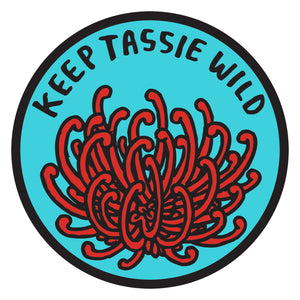By Eric J Woehler from BirdLife Tasmania
Despite the crowds brought in by Tassie’s recent tourism boom, Tasmania is a destination for more than just humans. An array of long-distance migratory birds have been visiting us from as far as the Arctic Circle for tens of thousands of years.
Most people are familiar with the remarkable Short-tailed Shearwater – the Tasmanian Muttonbird – that breeds around Tasmania, feeds in the Antarctic, then migrates each year to the North Pacific before returning to Tasmania to breed again. These long-lived birds, with some more than 40 years old and still breeding, will fly several million kilometres over their lifetimes – a remarkable achievement for a bird that weighs just 500g.

Illustration by Rachel Tribout (Captain Blueberry)
More remarkable still are the smaller migratory shorebirds that breed in the Arctic Tundra, in many cases north of the Arctic Circle, and migrate southward to Tasmania to avoid the deadly Arctic winters.
The smallest is the Red-necked Stint, which weighs just 25g and takes about 6 weeks to migrate in short flights between its Arctic breeding site and Tasmania, using coastal areas in Korea, China, Indonesia and northern Australia as recharging stations along the way. They will spend up to six months in Tasmania before setting off again to breed in the Arctic.
We know from banding studies that Red-necked Stints can live for more than 20 years. Each year, their annual migration route means that they fly more than 25,000km between the Arctic and Tasmania – over their lifetimes, these birds will fly farther than the distance between the Earth and the Moon – an amazing feat for a bird that would comfortably fit in the cup of your hand!

Bar-tailed Godwit by Eric Woehler
Perhaps even more extraordinary is the single-flight migration of the Bar-tailed Godwit. In preparation for their adventure these birds will nearly double their weight before they migrate from the Northern Hemisphere to their destinations in Australia and New Zealand. Satellite tracking of birds from Alaska showed that these birds flew non-stop from Alaska to New Zealand. During this flight the Bar-tailed Godwits lose 50% of their body weight as they travel the 11,000km over nine days. These flights don’t use tailwinds or any other assistance – the whole flight is powered by flapping -and is the longest single flight known for any bird.

Tasmania supports significant populations of migratory shorebirds on our beaches, coastal wetlands and lagoons. Eastern Curlew, Bar-tailed Godwits, Ruddy Turnstones, Red-necked Stints and many more species of migratory shorebirds from as far afield as Siberia and Alaska make Tasmania their annual international destination.
These migratory species join our resident shorebirds – the birds that are present on our beaches and foreshores every day of their lives. Surveys by BirdLife Tasmania have shown that Tasmania supports half the World’s populations of Eastern Hooded Plover, and Pied and Sooty Oystercatchers. These species are present on the Australian mainland, but their numbers are decreasing rapidly from the multitude of threats and the constant disturbance during the summer months when they try to nest on beaches.
We now know the national and international significance of Tasmania’s beaches for these species. Hooded Plover eggs would fit in a tea-spoon, their one- to two-day chicks in a soup spoon. Hooded Plovers and Pied Oystercatchers lay their 2 or 3 eggs on the sand after forming a shallow bowl in the sand as the nest. Here they are highly vulnerable to dogs, people, vehicles, horses and more – all the recreational activities that people undertake on our beaches in the summer months present threats to the nesting shorebirds.

Pied Oystercatcher by Eric Woehler
Pied Oystercatchers can live for more than 30 years – banding studies in southeast Tasmania have recorded individuals at least 33 years old. The resident shorebirds are dependent on the coast for feeding, breeding and shelter every day of their lives. They will typically stay within or close to their territory year round to ensure they have a territory to breed in the following summer. Visitors to the coasts around Tasmania will often see the same Pied Oystercatchers that have maintained a territory for 10, 20 or even 30 years – imagine the changes along the Tasmanian coasts these birds have witnessed over their lifetimes since the 1980s or 1990s!
With decreasing populations of migratory and resident shorebirds globally and on the Australian mainland, Tasmania is now recognised as a global refuge for our resident shorebird species, and a global destination for many species of Northern Hemisphere migrants. The Tasmania Parks and Wildlife Service, Councils and commercial operators are working with BirdLife Tasmania to protect these remarkable birds. Fencing to protect sensitive nesting habitats and signage to educate coastal (human) visitors are perhaps the most obvious of these efforts. Restriction on dogs and vehicles protect critical coastal areas – when owners and drivers heed them.

For more information on resident and migratory shorebirds, or any Tasmanian birds, please contact BirdLife Tasmania on tasmania@birdlife.org.au For details of BirdLife Tasmania surveys, outings and research efforts, please visit www.birdlife.org.au/tasmania

Dr Eric Woehler has been working on seabirds and shorebirds for 40 years. Over this time, he has undertaken extensive surveys of shorebirds and seabirds around Tasmania and farther afield. These surveys are critical for coastal conservation and management efforts around Tasmania, and are widely used by Councils, PWS and community groups. A keen photographer, he regularly engages with coastal communities to share his passion for birds. He is the Convenor of Birdlife Tasmania, a voluntary community-based conservation organisation, and is an Adjunct with the University of Tasmania where he teaches undergraduates and supervises a number of higher-degree students on Tasmania's birds.
